May 19, 2025 | 07:28 GMT +7
May 19, 2025 | 07:28 GMT +7
Hotline: 0913.378.918
May 19, 2025 | 07:28 GMT +7
Hotline: 0913.378.918
Provinces along the South Central Coast from Quang Nam - Da Nang to Binh Thuan have over 40,000 km2 of natural area, which isequivalent to about 12.5% of total country's area.
Unlike other types of natural disasters such as storms, floods, tsunamis, etc., drought occurs gradually over time. It is difficult to determine the beginning of the drought; and drought has caused significant economic, social and environmental damage. Drought is also a major cause of soil degradation and desertification. The world is currently facing desertification occurring at an alarming rate.
The South Central Coastal provinces have suffered from drought for the past few decades. Namely, the frequently dry areas in the Ninh Thuan and Binh Thuan provinces only have a rainfall level of 500 to 700 mm. Additionally, the hot and sunny climate in these areas has created an arid, sandy semi-desert with sparse and thorny shrubs, posing challenges to production development .
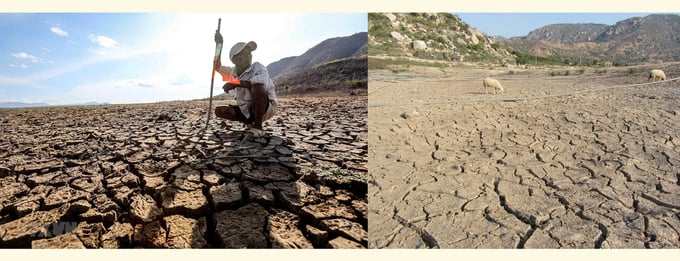
The South Central Coast is affected by the tropical monsoon climate with high temperature, hot and humid weather as well as high radiation. There are many high mountain ranges close to the sea in the region, the coastal plain is divided into parts that are completely separated from one another. This feature has affected the climate fission, forming sub-climate regions. Consequently, certain areas have frequent heavy rain whereas others are completely dry.
The region's topography is relatively complex, descending from west to east with mountains, hills, coastal plains and sea. There are very narrow coastal plains to the east, followed by low hills and stopping at the eastern slopes of the Truong Son mountain range.
The soil and vegetation cover on the sand dunes and beaches in the South Central Coast region is extremely sparse. There are artificial casuarina forests in coastal sand areas to block the wind and prevent sand from flying. In alluvial fields, the vegetation consists mainly of rice, peony, coconut, sugarcane, tobacco among many others.
There are multiple production areas for tea, rubber, and pepper on hills, however multiple plots of land have been deserted with only shrubs remaining. The slopes of the mountains were formerly dense forests, but they were cut down to accomodate food and industrial crops. Additionally, the unrestrained logging has caused the forest area to decrease gradually over the years, disrupting the natural balance.
The flood season lasts for 3 to 4 months every year, but the flow volume accounts for 75 to 80% of the annual flow, causing flooding and flash floods on the basin's surface.
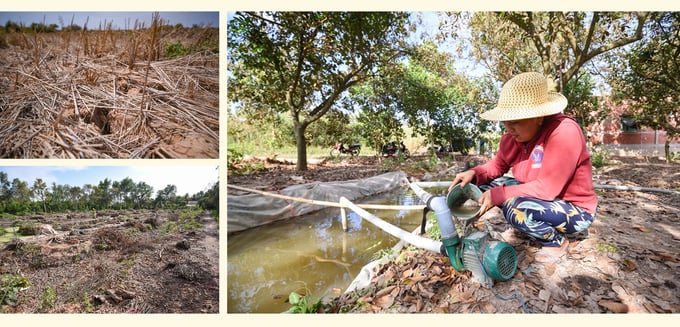
The dry season lasts for 8 to 9 months and the flow accounts for 20 to 25% of the annual flow, causing the rivers to dry up and draining the moisture from the soil.
Due to topographical features, the rivers and streams in the South Central Coast are short and steep. As a result, the water retention capacity of rivers and streams in the region is limited. Although the flow in rivers is not too low, the harsh natural conditions, coupled with strong socio-economic development has led to an increase in the demand for water. Consequently, water reservoirs in the region are usually empty during the dry season.
In summary, the population and socio-economic activities in the region towards sustainable development have not been evenly distributed, limiting the ability to prevent drought, causing adverse effects to the living environment of the community, degrading natural resources including land, water, etc. In addition to the impact of natural factors, socio-economic development activities have alleviated the effects of drought in the South Central Coast.
According to experts from the World Meteorological Organization (WMO), Vietnam and the South Central Coast region in particular were directly affected by the El Nino phenomenon from 2015 to 2016. This was one of the strongest and longest El Nino waves in history.
El Nino caused hot weather to arrive early and last longer, with a much higher number of hot days compared to the same period of previous years. Subsequently, the rainy season also arrived late and ended early with little rainfall, causing severe drought and water shortages in the South Central Coast provinces; with especially heavy damages to the provinces from Khanh Hoa to Binh Thuan from 2015 to 2016.

Due to the influence of El Nino, strong heat appeared early on a large scale at the beginning of 2016. The rainfall fell by 15 to 30 % compared to the average of many previous years; there was no rain in areas such as Ninh Thuan, Binh Thuan, Khanh Hoa, which had caused severe drought. Due to the drought and lack of water, the planting area of the 2015-2016 winter-spring crop had to be reduced by over 20,000 hectares.
Immediately afterwards in April 2016, many irrigation and hydroelectricity reservoirs in the South Central Coast did not store enough water to supply the summer-autumn crops. Only 10 out of a total of 22 lakes were capable of supplying the summer-autumn crop in Phu Yen province; the remaining lakes could only partially meet the water demand.
More recently, South Central Coast provinces including Khanh Hoa, Ninh Thuan, and Binh Thuan had unprecedentedly heavy droughts in 2020. Over 46,000 hectares of crops were abandoned in order to prioritize water for domestic use and livestock.
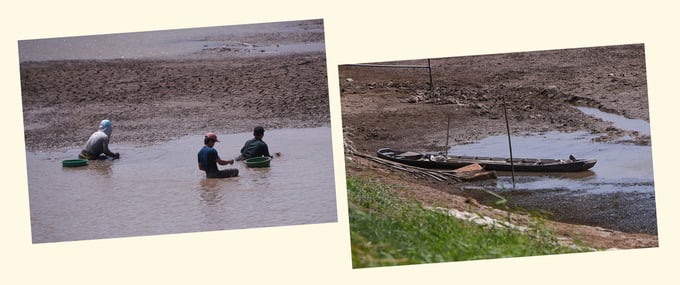
Statistics from the dry season of 2020 show that provinces in the South Central Coast had very little rainfall. Namely, Ninh Thuan and Binh Thuan provinces saw no rainfall during the first four months of the dry season. The total rainfall in the South Central Coast was 20-40% lower compared the average; The amount of flow dropped by 40-70%, some small rivers completely dried up. The hot weather and low rainfall had caused a serious drought; Binh Thuan and Ninh Thuan provinces had to announce a level 2 to 3 drought risk.
Facing the severe drought situation at the time, provinces in the South Central Coast implemented the Official Letter by the Prime Minister and actively developed plans to cope with drought and water shortage.
According to many domestic and international experts, the drought in the South Central Coast region will continue to be complicated and unpredictable in the near future; especially in the context of increasingly severe climate change.
With the goal of fundamentally solving drought and water shortages for the South Central provinces by 2025 as well as ensuring water security, the Ministry of Agriculture and Rural Development has organized many delegations to work with localities on water resources, drought response, offering many structural and non-structural solutions to support and resolve local difficulties, ensuring production stability and social security.
Some non-structural solutions include: restructuring the agricultural sector, calculating the reasonable conversion of crops to adapt to the conditions and water capacity of each locality; effectively developing and managing forests; increasing forest cover area, with special focus on watershed forests; increasing water retention capacity, preventing landslides. These solutions will help to protect the ecological environment and develop the economy.
With the current coverage rate, it is necessary to increase the planting of several protective forest areas to enhance the flow regulation. In addition, it is necessary to invest further in the treatment of wastewater and the quality management of wastewater discharged into water sources.
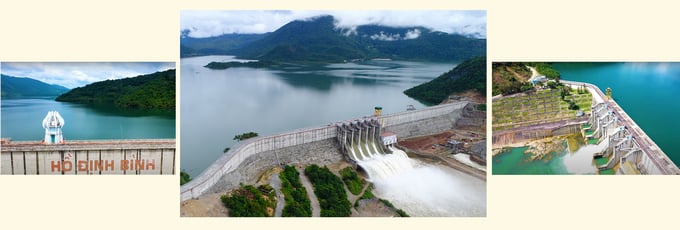
Regarding structural solutions, priority must be given to the perfecting and strengthening of the irrigation system, with focus on water transfer channels, in-field canals. It is also necessary to invest in the construction of large and key irrigation works.
Another important solution is to connect inter-lakes and basins such as Tan My lake in Ninh Thuan province with Song Trau lake, Ba Rau lake, Song Sat lake and transfer water through the southern area of Cam Ranh city, Khanh Hoa province; or Tan Giang lake with Song Bieu lake in Ninh Thuan province.
In order to improve adaptability to climate change as well as ensure sustainable development of the agricultural sector, the construction of Irrigation network connection between reservoirs with the purpose of transfering water between basins, utilizing water in the flood season for the dry season is essential.
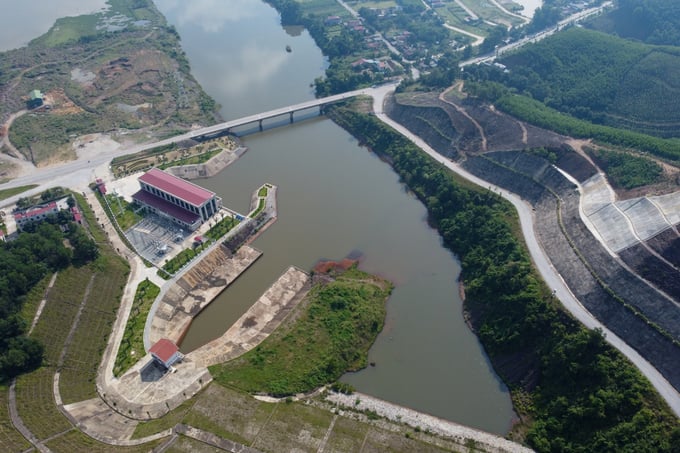
“The implementation of the interconnection network between reservoirs in Ninh Thuan is convenient, because large irrigation works are located upstream and the lakes are in close proximity. The construction can solve the drought problem for the entire province", shared Mr. Dang Kim Cuong, Director of Ninh Thuan Department of Agriculture and Rural Development.
Mr. Nguyen Van Binh, Head of the Specialized Department under the Ninh Thuan Department of Agriculture and Rural Development, said that the Tan My irrigation project has been partially completed and handed over the province.
In order to maximize the effectiveness of this project, the Ministry of Agriculture and Rural Development has approved the investment in a steel pipe canal system with a length of 15km, with 12km to bring water to Song Trau lake and 3km to bring water to Ba Rau lake in order to supply irrigation as well as provide water to these lakes during the dry season.
It is expected that, the interconnection between Tan My Lake and other reservoirs will be completed by 2025. This construction can ensure water for agricultural production as well as other water use needs, solving the water shortages in the coastal districts of Thuan Bac and Ninh Hai.
Translated by Nguyen Hai Long

(VAN) 14 out of 35 domesticated elephants in Dak Lak province have had their living conditions improved, with 11 of them currently participating in the non-riding elephant tourism model.

(VAN) Muong Nhe Nature Reserve hopes that being upgraded to a national park will lay the foundation for forest protection efforts to be carried out in a systematic, modern, and sustainable manner.
/2025/05/16/3923-2-171845_52.jpg)
(VAN) Lower costs, higher yields, and improved soil quality are outstanding benefits that soybeans bring when integrated into the crop rotation system.
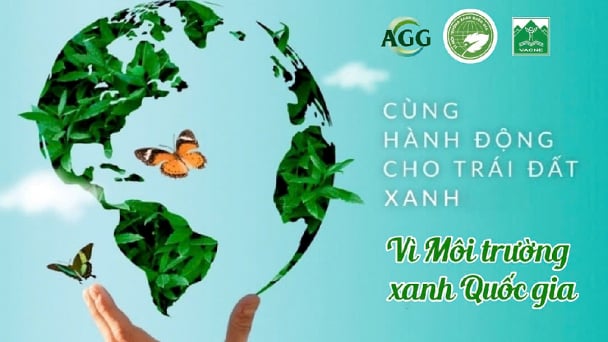
(VAN) The 'For a Green National Environment' programme aims to promote a green lifestyle, support businesses in implementing ESG practices, and turn Net Zero commitments into concrete actions.

(VAN) Cold-barn systems efficiently manage environmental and temperature conditions, which aids in the prevention of respiratory diseases in pigs and protects them from the vectors that transmit African swine fevers.

(VAN) To tackle challenges, the project 'Addressing key technical bottlenecks in the grouper supply chain in Vietnam' has been underway since 2024.

(VAN) The project 'Disease-Resilient and Sustainable Cassava Production Systems in the Mekong Region', funded by the Australian Center for International Agricultural Research (ACIAR), is being implemented from 2024 to 2028.